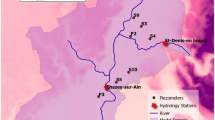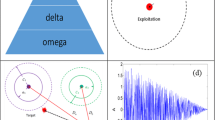Abstract
Saltwater intrusion management models can be used to derive optimal and efficient management strategies for controlling saltwater intrusion in coastal aquifers. To obtain physically meaningful optimal management strategies, the physical processes involved need to be simulated while deriving the management strategies. The flow and transport processes involved in coastal aquifers are difficult to simulate especially when the density-dependent flow and transport processes need to be modeled. Incorporation of this simulation model within an optimization-based management model is very complex and difficult. However, as an alternative, it is possible to link a simulation model externally with an optimization-based management model. The GA-based optimization approach is especially suitable for externally linking the numerical simulation model within the optimization model. Further efficiency in computational procedure can be achieved for such a linked model, if the simulation process can be simplified by approximation, as very large number of iterations between the optimization and simulation model is generally necessary to evolve an optimal management strategy. A possible approach for approximating the simulation model is to use a trained Artificial Neural Network (ANN) as the approximate simulator. Therefore, an ANN model is trained as an approximator of the three dimensional density-dependent flow and transport processes in a coastal aquifer. A linked simulation – optimization model is then developed to link the trained ANN with the GA-based optimization model for solving saltwater management problems. The performance of the developed optimization model is evaluated using an illustrative study area. The evaluation results show the potential applicability of the developed methodology using a GA- and ANN-based linked optimization – simulation model for optimal management of coastal aquifer.
Similar content being viewed by others
References
Alley, W. M., 1986, ‘Regression approximation for transport model constraint sets in combined aquifer simulation-optimization studies’, Water Resour. Res. 22(4), 581–586.
Aly, A. H. and Peralta, R. C., 1999a, ‘Optimal design of aquifer cleanup systems under uncertainty using a neural network and genetic algorithms’, Water Resour. Res. 35(8), 2523–2532.
Aly, A. H., and Peralta, R. C., 1999b, ‘Comparison of a genetic algorithm and mathematical programming to the groundwater cleanup systems’, Water Resour. Res. 35(8), 2415–2425.
Bear, J. and Dagan, G., 1964, ‘Some exact solutions of interface problems by means of the hodograph method’, J. Geophys Res. 69, 1563–1572.
Cheng, J. M. and Chen, C. X., 2001, ‘Three-dimensional modeling of density-dependent saltwater intrusion in multilayered coastal aquifers in Jahe river basin, Shandong province, China’, Ground Water, 39(1), 137–143.
Cieniawski, S. E., Eheart, J. W. and Ranjithan, S., 1995, ‘Using genetic algorithms to solve a multiobjective groundwater monitoring problem’, Water Resour. Res. 31(2), 399–409.
Das, A. and Datta, B., 1999a, ‘Development of management models for sustainable use of coastal aquifers’, J. Irrg. Drainage Eng. ASCE 125(3), 112–121.
Das, A. and Datta, B., 1999b, ‘Development of multiobjective management models for coastal aquifers’, J. Water Resour. Plan. Manage. ASCE. 125(2), 76–87.
Das, A. and Datta, B., 2000, ‘Optimization based solution of density-dependent seawater intrusion in coastal aquifers’, J. Hydrol. Eng. 5(1), 82–89.
Deb, K., 2000, ‘An efficient constraint handling method for genetic algorithms’, Comput. Methods Appl. Mech. Eng. 186, 311–338.
Deb, K., 2001, Multi-Objective Optimization Using Evolutionary Algorithms, Wiley, UK.
Ejaz, M. S. and Peralta, R. C., 1985, ‘Modeling for optimal management of agricultural and domestic wastewater loading to streams’, Water Resour. Res. 31(4), 1087–1096.
Emch, P. G. and Yeh, W. W.-G., 1998, ‘Management model for conjunctive use of coastal surface water and ground water’, J. Water Resour. Plan. Manage. ASCE 124(3), 129–139.
Essink, G. H. P. O., 2001, ‘Saltwater intrusion in 3D Large Scale aquifers: A Dutch case’ Phys. Chem. Earth 26(4), 337–344.
Galeati, G., Gambolati, G. and Neuman, S. P., 1992, ‘Coupled and partially coupled Eulerian–Lagrangian model for freshwater–seawater mixing’, Water Resour. Res. 28(1), 147–165.
Galeati, G., Gambolati, G. and Neuman, S. P. 1992, ‘Coupled and partially coupled Eulerian–Lagrangian model for freshwater–seawater mixing’, Water Resour. Res. 28(1), 147–165.
Goldberg, D. E., 2000, Genetic Algorithms in Search, Optimization, and in Machine Learning, Addison Wiley, Bangalore, India.
Gorelick, S. M., 1983, ‘A review of distributed parameter groundwater management modeling methods’, Water Resour. Res. 19(2), 305–319.
Hantush, M. S., 1968, ‘Unsteady movement of freshwater in thick unconfined saline aquifers’, Bull. Int. Assoc. Sci. Hydrol. XIII(2), 40–60.
Henry, H. R., 1959, ‘Salwater intrusion into freshwater aquifers’, J. Geophys. Res. 64, 1911–1919.
Holland, J. H., 1975, Adaptation in Natural and Artificial Systems, University of Michigan Press, Michigan.
Huyakorn, P. S., Andersen, P. F., Mercer, J. W. and White H. O., 1987, ‘Saltwater intrusion inaquifers: Development and testing of a three-dimensional finite element model’, Water Resour. Res. 23(2), 293–312.
Johnson, V. M. and Rogers, L. L., 2000, ‘Accuracy of neural network approximations in simulation–optimization’, J. Water Resour. Plan. Manage. ASCE 126(2), 48–56.
Liu, P. L.-F., Cheng, J. A. and Lee, J. H., 1981, ‘Boundary integral equation solutions of moving interface between two fluids in porous media’, Water Resour. Res. 17(5), 1445–1452.
Lefkoff, L. J. and Gorelick, S. M., 1990, ‘Simulating physical processes and economic behavior in saline, irrigated agriculture: Model develpment’, Water Resour. Res. 26(7), 1359–1369.
McKinney, D. C., and Lin, M.-D., 1994, ‘Genetic algorithms solution of groundwater management models’, Water Resour. Res. 30(4), 1897–1906.
Mercer, J. W., Larson, S. P. and Faust, C. R., 1980, ‘Simulation of saltwater interface motion’, Ground Water 18(4), 374–385.
Morshed, J. and Kaluarachchi, J. J., 1998, ‘Application of artificial neural networks and genetic algorithms in flow and transport simulation’, Adv. Water Resour. 22(2), 145–158.
Morshed, J. and Kaluarachchi, J., 2000, ‘Enhancements to genetic algorithm for optimalground-water management’, J. Hydrol. Eng. ASCE 5(1), 67–73.
Murtagh, B. A. and Saunders, M. A., 1993, ‘MINOS 5:4 user’s guide, technical report, SOL 83-20R’, Systems Optimization Laboratory, Department of Operation Research, Stanford University, Stanford, California, 94305–4022.
Pinder, G. F. and Page, R. H., 1977, ‘Finite element simulation of salt water intrusion on the South Fork of Long Island’, Proceedings of the 1st International Conference on Finite Elements in Water Resources, Pentech Press, London, pp. 2.51–2.69.
Putti, M. and Paniconi, C., 1995, ‘Picard and Newton linearization for the coupled model of saltwater intrusion in aquifers’, Adv. Water Resour. 18(3), 159–170.
Ritzel, B. J., Eheart, J. W. and Ranjithan, S., 1994, ‘Using genetic algorithms to solve a multiple objective groundwater pollution containment problem’, Water Resour. Res. 30(5), 1589–1603.
Rogers, L. L. and Dowla, F. U., 1994, ‘Optimization of ground water remediation using artificial neural networks and parallel solute transport modeling’, Water Resour. Res. 30(2), 457–481.
Rosenwald, G. W., and Green, D. W., 1974, ‘A method for determining the optimal location of wells in a reservoir using mixed-integer programming’, Soc. Res. Eng. J. 14, 44–54.
Shamir, U. and Dagan, G., 1971, ‘Motion of the seawater interface in coastal aquifers: A numerical solution’, Water Resour. Res. 7(3), 644–657.
Simpson, M. J. and Clement, T. P., 2003, ‘Theoretical analysis of the worthiness of Henry and Elderproblems as bench Marks of density-dependent groundwater flow model’, Adv. Water Resour. 26(1), 17–31.
Strack, O. D. L., 1976, ‘A single-potential solution for regional interface problems in coastal aquifers’, Water Resour. Res. 12(6), 1165–1174.
Taigbenu, A. E., Liggett, J. A. and Cheng, A. H. D., 1984, ‘Bioundary integral solution to seawater intrusion into coastal aquifers’, Water Resour. Res. 20(8), 1150–1158.
Willis, R. and Finney, B. A., 1988, ‘Planning model for optimal control of saltwater intrusion’,J. Water Resour. Plan. Manage. ASCE 114(2), 163–178.
Author information
Authors and Affiliations
Corresponding author
Rights and permissions
About this article
Cite this article
Bhattacharjya, R.K., Datta, B. Optimal Management of Coastal Aquifers Using Linked Simulation Optimization Approach. Water Resour Manage 19, 295–320 (2005). https://doi.org/10.1007/s11269-005-3180-9
Received:
Accepted:
Issue Date:
DOI: https://doi.org/10.1007/s11269-005-3180-9




